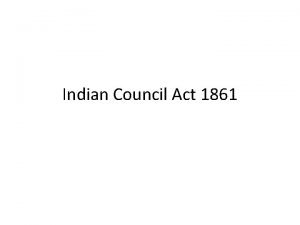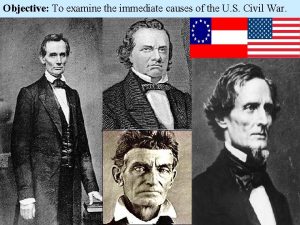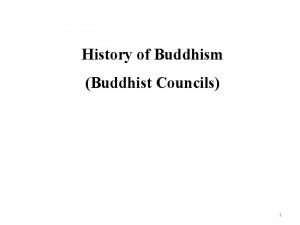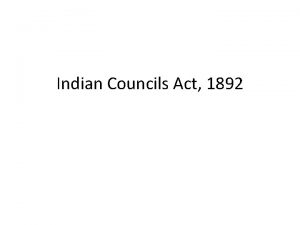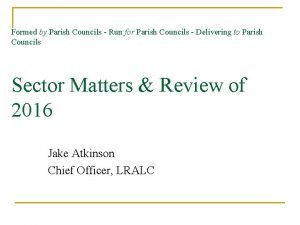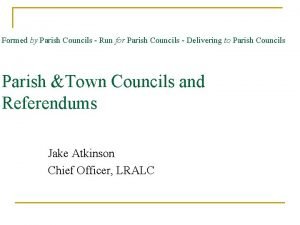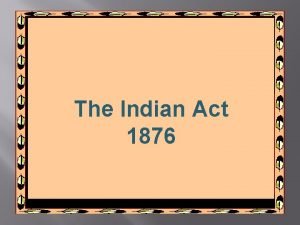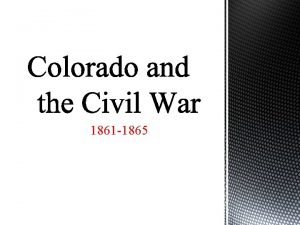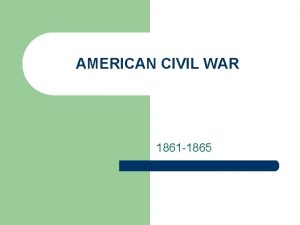Indian Council Act 1861 The Indian Councils Act





























- Slides: 29

Indian Council Act 1861


• The Indian Councils Act 1861 was passed by British Parliament on 1 st August 1861 to make substantial changes in the composition of the Governor General’s council for executive & legislative purposes. The most significant feature of this Act was the association of Indians with the legislation work.


Reasons for Enactment of Indian Councils Act • Aftermath of the Mutiny of 1857, there was a general perception in England that it would be very difficult to secure the government in India without the cooperation of Indians in administration. • The Government of India Act 1858 had introduced significant changes in the manner in which India was governed from England, however, it did not alter in any substantial way the system of government that prevailed in India.


Centralized law making was defective • The Charter act of 1833 had centralized the legislative procedures and deprived the governments of Madras and Bombay of their power of legislation. • It had only one representative each of the four provinces and it failed to make laws suiting to local conditions • Thus, there was need to allow the provinces to make laws for themselves.


Governor General in Council was overburdened • The Governor General in Council was failing in its legislative functions and was not able to work satisfactorily die to cumbersome procedures leading to delay in enactments.


Absence of representation • It also had no representation of the people in it. There was a growing demand that some representative element should be introduced in legislative council.


Salient Features of the Act • Expansion of executive council of Governor General / Viceroy • The executive council of Governor General was added a fifth finance member. For legislative purpose, a provision was made for an addition of 6 to 12 members to the central executive. At least half of the additional members were to be non-officials. ( English or Indian). These members were nominated by the Viceroy for the period of two years. • .


Further, the Governor General / Viceroy had been given some more powers such as: • He was authorized to nominate a president to preside over the meetings of the Executive council in his absence. • He had the power of making rules and regulations for the conduct of business of executive council. • He could create new provinces for legislative purposes and to appoint Lieutenant Governors for them. He was also empowered to alter, modify or adjust the limits of the provinces. • He could promulgate ordinances, without the concurrence of the legislative council, during and emergency. • Though the central council was empowered to legislate on all subjects concerning all persons and courts in British India but every bill passed required the assent of viceroy. • He could withhold his assent or exercise his veto power if he felt that the bill affected the safety, peace and interest of British India. • He had to communicate all laws to secretary of state for India who could disallow them with the assent of the crown.


Introduction of Portfolio System • The Act empowered the Governor-General to delegate special task to individual members of the Executive council and hence all members have their own portfolio and death with their own initiative with all but the most important matters. This was the first beginning of Portfolio system in India.


Process of Decentralization • The Governments of Bombay and Madras were given the power of nominating Advocate-General and not less than 4 and not more than 8 additional members of the Executive council for purpose of legislation. These additional members were to hold office for two years. The consent of the Governor and the Governor. General was made necessary for all legislation passed or amended by the Governments of Madras and Bombay. Further, the act provided for the establishment of new legislative councils for Bengal, North-Western Frontier Province and Punjab, which were established in 1862, 1866, and 1897 respectively.


No distinction between Central and Provincial subjects • No distinction was made between the central and provincial subject. But measures concerning public debt, finances, currency, post-office, telegraph, religion, patents and copyrights were to be ordinarily considered by the Central Government.


From British Point of view • The Secretary of state for India at the time of the act was passed, Sir Charles Wood, believed that the act was of immense importance: “the act is a great experiment. That everything is changing in India is obvious enough, and that the old autocratic government cannot stand unmodified is indisputable. ”


Indian Point of view • However from Indian point of view the act did little to improve the influence of Indians in the legislative council. The role of council was limited to advice. No financial discussion could take place. • the legislative councils were merely talk shops with no power to criticize the administration or ask for some information. Their scope was fixed in legislation purpose alone; they had no right to move some kind of vote of no confidence. Further, there was no statutory / specific provision for the nomination of Indians.



References • Adhunik Bharat ka Itihas- Bipin Chandra • Legal and constitutional History of India- V. D. Kulshreshtha • Legal History- Kailash Rai • Legal and Constitutional History of India- N. V. Paranjape • www. wikipedia. org • History of Modern India- Bipin Chandra

Thank You • Dr. Neeta Yadav • Assistant professor • B. J. R. Institute of Law • Bundelkhand University Jhansi
 Indian councils act of 1861
Indian councils act of 1861 Currie v misa
Currie v misa Civil war 1861/1862
Civil war 1861/1862 South carolina 1861
South carolina 1861 Civil war 1861/1862
Civil war 1861/1862 Tensionometer
Tensionometer Unionistička stranka 1861
Unionistička stranka 1861 Springfield model 1861 rifle facts
Springfield model 1861 rifle facts Derbyshire association of local councils
Derbyshire association of local councils Sa councils
Sa councils Best practices of catholic pastoral and finance councils
Best practices of catholic pastoral and finance councils Fourth buddhist council filled by the emperor
Fourth buddhist council filled by the emperor Customer councils
Customer councils Lummi indian business council
Lummi indian business council Glasgow thang điểm
Glasgow thang điểm ưu thế lai là gì
ưu thế lai là gì Thẻ vin
Thẻ vin Cái miệng xinh xinh thế chỉ nói điều hay thôi
Cái miệng xinh xinh thế chỉ nói điều hay thôi Các châu lục và đại dương trên thế giới
Các châu lục và đại dương trên thế giới Bổ thể
Bổ thể Từ ngữ thể hiện lòng nhân hậu
Từ ngữ thể hiện lòng nhân hậu Diễn thế sinh thái là
Diễn thế sinh thái là Tư thế ngồi viết
Tư thế ngồi viết Ví dụ giọng cùng tên
Ví dụ giọng cùng tên Phép trừ bù
Phép trừ bù Thể thơ truyền thống
Thể thơ truyền thống Hát lên người ơi
Hát lên người ơi Sự nuôi và dạy con của hươu
Sự nuôi và dạy con của hươu đại từ thay thế
đại từ thay thế Vẽ hình chiếu vuông góc của vật thể sau
Vẽ hình chiếu vuông góc của vật thể sau
